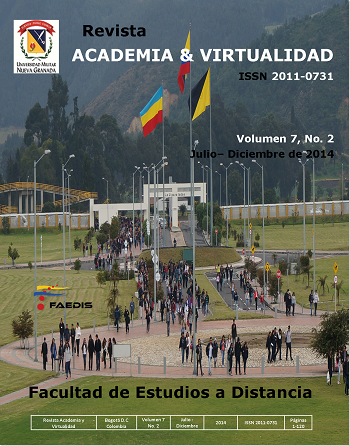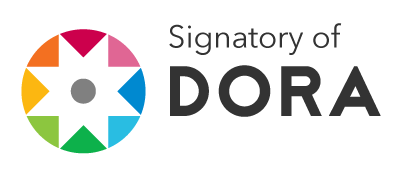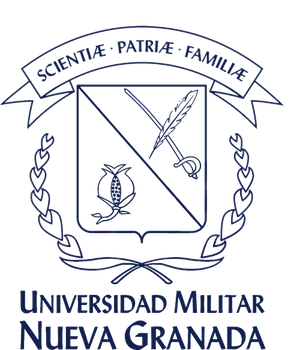LEARNING BY DOING – RESEARCHING BY REFLECTION – A PARALLEL STUDY CASE IN COLOMBIA AND CHILE
Abstract
This paper offers a reflection on methodological constructionism postures that integrate ICT, including the WebQuest, digital learning objects, E-learning platforms, among others, due to the current boom takes on new goals and challenges with futuristic vision society. Therefore, the reflection on the teaching-learning opens a case study proposed to assess as the metabolism of the classroom has changed mainly due to the massive use of ICT provides students apply a methodology of distributed information in different and varied sources of information removing the centralized methodology to prepare by learning by doing and reflecting investigate. Thus, in the university research is part of the work initially become student research assistant and that is where an analysis of the effects is necessary because their research in the socio-cultural and productive environment in which it operates. Thereby this case study was developed in Research Group in Telemedicine of Nueva Granada Military University –TIGUM from Colombia, and New Technologies of Santiago de Chile University -GINT during 2012 and 2013 have made an exploratory study parallel applying the methodology “learning by doing - reflecting investigate” that allows evaluating the results of research and professional development of its participants auxiliary. As a result, more than 80% of assistant researches are developing their postgraduate studies at Masters or PhD at the national or international level.Downloads
References
Argyris, C. & Schön, D. (1996). Organizational learning II: Theory, method and practice, Reading, Mass: Addison Wesley.
Berlin, D.F. (1996). “Action research in the science classroom: Curriculum improvement and teacher professional development”. In: J. Rhoton y P. Bowers (Eds.), Issues in science education (pp. 73-80).
Bunge, M. (2007). A la caza de la realidad. La controversia sobre el realismo. Barcelona: Editorial Gedisa. Versión castellana de Mario Bunge: Chasing Reality: Strife over Realism. Toronto, University of Toronto Press, 2006
Chi, M.T.H., et al. (1989). “Self-explanations: How students study and use examples in learning to solve problems”. In: Cognitive Science, 13, 145- 182.
Dale, E. (1932). “Methods for Analyzing the Content of Motion Pictures”. In: Journal of Educational Sociology, 6: 244-250.
Dewey, J. (1952) La búsqueda de la certeza: un estudio de la relación entre el conocimiento y la acción. Trad. Eugenio Imaz, México, Fondo de Cultura Económica.
Eisner, E.W. (1998). The Enlightened Eye. Qualitative inquiry and the enhancement of educational practice, Upper Saddle River, NJ: Prentice Hall.
Elliott, J. (1986). “Action-Research: normas para la autoevaluación en los colegios”. En: L. Haynes (Ed.), Investigación-acción en el aula (pp. 21-48).
Feldman, A. (1996). “Enhancing the practice of physics teachers. Mechanisms for the generation and sharing of knowledge and understanding in collaborative action research”. In: Journal of Research of Science Teaching, 33, 513-540.
Fulmer, R.M. (1994). A model for changing the way organizations learn. Planning Review a publication of the Planning Forum, May-June 1994:20.-
Guenter, L.H. (2012). “Co-evaluación de experiencias basadas”. En: Aprender haciendo y realimentación desde aprender haciendo hasta el aprendizaje activo. Universidad Earth, Costa Rica.
Harrison, R. (1969). “Communication Theory”. In: R. V. Wiman & W. C. Meierhenry (Eds.) Educational Media: Theory into Practice. Columbus, OH: Merrill.
Jay, J.K., & Johnson, K.L. (2002). “Capturing complexity: A typology of reflective practice for teacher education”. In: Teaching and Teacher Education, 18, 73-86.
Jonassen, D.H., Mayes, T., & McAleese, R. (1993). “A manifest for constructivist approaches to uses of technology in higher education”. In: T.M. Duffy, J. Lowyck & D.H. Jonassen (eds.) Designing environments for constructive learning (pp. 231- 247). Berlin: Springer.
Kanfer, F.H. (1977). “Selbstmanagement-Methoden” [Métodos de ser gerente de sí-mismo]. En: F. H. Kanfer & A. P. Goldstein (Comps.), Möglichkeiten der Verhaltensänderung. Munchen: Urban & Schwarzenberg.
Kulik, J.A. & Kulik, C-L.C. (1988). “Timing of feedback and verbal learning”. In: Review of Educational Research, 58, 79-97.
Lave, J. & Wenger, E. (1991). Situated learning. Legitimate peripheral participation. Cambridge: Cambridge University Press.
Mayer, R.E. (2000). “What is the place of science in educational research?” In: Educational Researcher, Vol. 29, No. 6, pp. 38-39.
Miller, J.L. (1992). “Exploring power and authority issues in a collaborative research project”. In: Theory Into Practice, 31, 165-172.
Moerbeke, G. (1982) Metafísica. Trad. de Valentín García Yebra, Metafísica de Aristóteles, Edición trilingüe, Madrid, Gredos, 1982.
Newman, S. (1999) Philosophy and Teacher Education: A Reinterpretation of Donald A. Schon’s Epistemology of Reflective Practice, London: Avebury.
Nyden, P. & W. Wiewel (1992). “Collaborative research: Harnessing the tensions between researcher and practitioner”. In: The American Sociologist, 23, 43-55.
Pakman, M. (2000). ”Thematic Foreword: Reflective Practices: The Legacy Of Donald Schön”. In: Cybernetics & Human Knowing, Vol.7, No. 2-3, pp. 5-8. http://www.imprint.co.uk/C&HK/vol7/
Pakman_foreword.PDF Parke, H.M. & C.R. Coble (1997). “Teachers designing curriculum as professional development: A model for transformational science teaching”. In: Journal of Research in Science Teaching, 34, 773-790
Putnam, H & Ruth A. (1992). “William James’s Ideas”, Realism with and Human Face, Cambridge, Mass., Harvard University Press.
Rogoff, B. (1995). “Observing sociocultural activity on three planes: participatory appropriation, guided participation, and apprenticeship”. In: J.V. Wertsch, P. del Rio & A. Álvarez (Eds.), Sociocultural Studies of Mind (pp. 139-164).Cambridge: Cambridge University Press.
Schön, D. (1991). The Reflective Turn: Case studies in and on educational practice. New York: Teachers College (Columbia).
__________. (1987). Educating the Reflective Practitioner, San Francisco: Jossey-Bass. 355 + xvii pages.
Shuell, T.J. (1986). “Cognitive conceptions of learning”. In: Review of Educational Research, 56, 411-436.
Stern, D. & Huber, G.L. (Eds.) (1997). Active learning for students and teachers. Reports from eight countries. Frankfurt A.M.: Peter Lang Verlag & OECD.
Stewart, D.K. (1969). “A learning-systems concept as applied to courses in education and training”. In: R. V. Wiman and W. C. Meierhenry (Eds.) Educational media: Theory into practice. Columbus, OH: Merrill.
Suárez, M. (1998). “Desarrollo de un grupo de investigación-acción colaboradora en proyectos curriculares innovadores”. En: Revista de Educación, 316, 369-382.
Treichler, D.G. (1967). Are you missing the boat in training aids? Film and Audio-Visual Communication, 1, 14-16, 28-30, 48.
Vygotsky, L.S. (2002). Denken und Sprechen. Psychologische Untersuchungen [Pensar y hablar. Indagaciones psicológicas]. Weinheim: Beltz.
Wals, A.E.J. y A.H. Alblas (1997). “School-based research and development of environmental education: a case study”. In: Environmental Education Research, 3, 253-267.
Wiman, R.V. & Meierhenry, W.C. (Eds.). (1969). Educational media: Theory into practice. Columbus, OH: Merrill.
Wompner F y Montt F. (2007). “Aprender a aprender. Un método valioso para la educación superior”. Observatorio de la Economía Latinoamericana 72. Texto completo en www.eumed.net/cursecon/ ecolat/cl/
Zuber-Skerritt, O. (1996). “Introduction: New directions in action research”. En: O. Zuber-Skerritt (Ed.), New Directions in Action Research (pp. 3-9). Washington, DC: Falmer Press.











